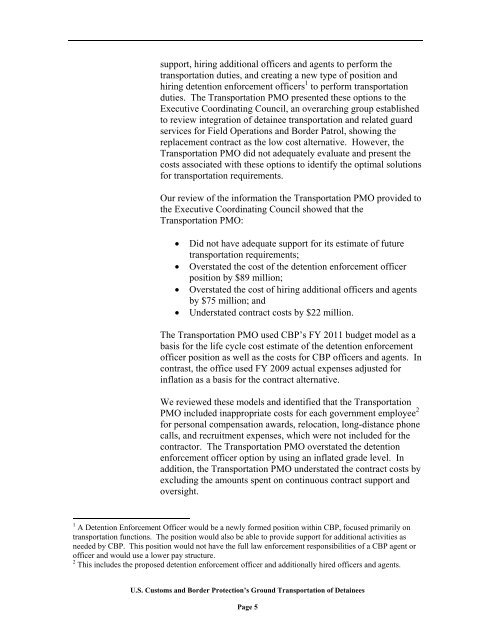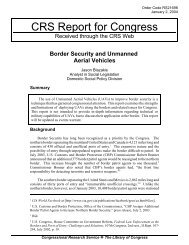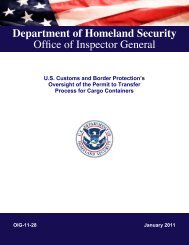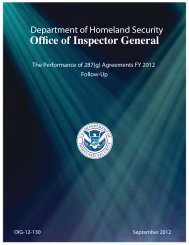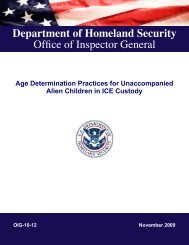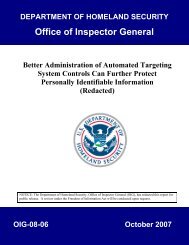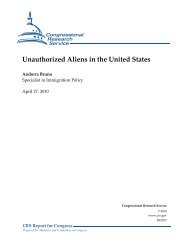US Customs and Border Protection's Ground Transportation of ...
US Customs and Border Protection's Ground Transportation of ...
US Customs and Border Protection's Ground Transportation of ...
- No tags were found...
You also want an ePaper? Increase the reach of your titles
YUMPU automatically turns print PDFs into web optimized ePapers that Google loves.
support, hiring additional <strong>of</strong>ficers <strong>and</strong> agents to perform thetransportation duties, <strong>and</strong> creating a new type <strong>of</strong> position <strong>and</strong>hiring detention enforcement <strong>of</strong>ficers 1 to perform transportationduties. The <strong>Transportation</strong> PMO presented these options to theExecutive Coordinating Council, an overarching group establishedto review integration <strong>of</strong> detainee transportation <strong>and</strong> related guardservices for Field Operations <strong>and</strong> <strong>Border</strong> Patrol, showing thereplacement contract as the low cost alternative. However, the<strong>Transportation</strong> PMO did not adequately evaluate <strong>and</strong> present thecosts associated with these options to identify the optimal solutionsfor transportation requirements.Our review <strong>of</strong> the information the <strong>Transportation</strong> PMO provided tothe Executive Coordinating Council showed that the<strong>Transportation</strong> PMO:• Did not have adequate support for its estimate <strong>of</strong> futuretransportation requirements;• Overstated the cost <strong>of</strong> the detention enforcement <strong>of</strong>ficerposition by $89 million;• Overstated the cost <strong>of</strong> hiring additional <strong>of</strong>ficers <strong>and</strong> agentsby $75 million; <strong>and</strong>• Understated contract costs by $22 million.The <strong>Transportation</strong> PMO used CBP’s FY 2011 budget model as abasis for the life cycle cost estimate <strong>of</strong> the detention enforcement<strong>of</strong>ficer position as well as the costs for CBP <strong>of</strong>ficers <strong>and</strong> agents. Incontrast, the <strong>of</strong>fice used FY 2009 actual expenses adjusted forinflation as a basis for the contract alternative.We reviewed these models <strong>and</strong> identified that the <strong>Transportation</strong>PMO included inappropriate costs for each government employee 2for personal compensation awards, relocation, long-distance phonecalls, <strong>and</strong> recruitment expenses, which were not included for thecontractor. The <strong>Transportation</strong> PMO overstated the detentionenforcement <strong>of</strong>ficer option by using an inflated grade level. Inaddition, the <strong>Transportation</strong> PMO understated the contract costs byexcluding the amounts spent on continuous contract support <strong>and</strong>oversight.1A Detention Enforcement Officer would be a newly formed position within CBP, focused primarily ontransportation functions. The position would also be able to provide support for additional activities asneeded by CBP. This position would not have the full law enforcement responsibilities <strong>of</strong> a CBP agent or<strong>of</strong>ficer <strong>and</strong> would use a lower pay structure.2 This includes the proposed detention enforcement <strong>of</strong>ficer <strong>and</strong> additionally hired <strong>of</strong>ficers <strong>and</strong> agents.U.S. <strong>Customs</strong> <strong>and</strong> <strong>Border</strong> Protection’s <strong>Ground</strong> <strong>Transportation</strong> <strong>of</strong> Detainees Page 5


